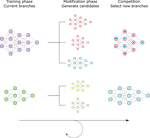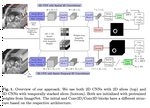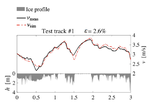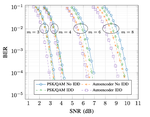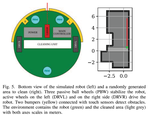Machine Learning based Prediction of Ditching Loads
We present approaches to predict dynamic ditching loads on aircraft fuselages using machine learning. The employed learning procedure …
Hidden Node-Aware Dynamic Spectrum Access using Deep Learning for Coexisting Aeronautical Communication Systems
We propose a novel approach based on deep learning to address the hidden node problem which occurs in the coexistence of aeronautical …
In-Network Round-Trip Time Estimation for TCP Flows
Transmission Control Protocol (TCP)‘s tendency to fill up buffers in the network results in long standing queues. Active Queue …
Reconstructing the infrared spectrum of a peptide from representative conformers of the full canonical ensemble
Leucine enkephalin (LeuEnk), a biologically active endogenous opioid pentapeptide, has been under intense investigation because it is …
Machine Learning Models for Photonic Crystals Band Diagram Prediction and Gap Optimisation
Data-driven methods of machine learning (ML) have attracted a lot of interest in various fields of physics. Inverse design and …
Deep Learning-Based Dynamic Spectrum Access for Coexistence of Aeronautical Communication Systems
In aeronautical communications, legacy systems often only use a small fraction of their historically assigned frequency spectra …
A Machine Learning Perspective on Automotive Radar Direction of Arrival Estimation
Millimeter-wave sensing using automotive radar imposes high requirements on the applied signal processing in order to obtain the …
Predicting the Inhibition Efficiencies of Magnesium Dissolution Modulators using Sparse Machine Learning Models
The degradation behaviour of magnesium and its alloys can be tuned by small organic molecules. However, an automatic identification of …
Global predictions of primary soil salinization under changing climate in the 21st century
Soil salinization has become one of the major environmental and socioeconomic issues globally and this is expected to be exacerbated …
Active learning of potential-energy surfaces of weakly bound complexes with regression-tree ensembles
Several pool-based active learning (AL) algorithms were employed to model potential-energy surfaces (PESs) with a minimum number of …
Time- and Frequency-Domain Dynamic Spectrum Access: Learning Cyclic Medium Access Patterns in Partially Observable Environments
Upcoming communication systems increasingly often tackle the spectrum scarcity problem through the coexistence with legacy systems in …
bSTAB: an open-source software for computing the basin stability of multi-stable dynamical systems
The pervasiveness of multi-stability in nonlinear dynamical systems calls for novel concepts of stability and a consistent …
Data-Driven Radar Processing Using a Parametric Convolutional Neural Network for Human Activity Classification
The paper proposes a data-driven pre-processing optimization for radar data using a parametric convolutional neural network. The …
Neural network surgery: Combining training with topology optimization
With ever increasing computational capacities, neural networks become more and more proficient at solving complex tasks. However, …
Explainable machine learning: A case study on impedance tube measurements
Machine learning (ML) techniques allow for finding hidden patterns and signatures in data. Currently, these methods are gaining …
QMA: A Resource-efficient, Q-learning-based Multiple Access Scheme for the IIoT
Many MAC protocols for the Industrial Internet of Things, such as IEEE 802.15.4 and its extensions, require contention-based channel …
Exploring the application of reinforcement learning to wind farm control
Optimal control of wind farms to maximize power is a challenging task since the wake interaction between the turbines is a highly …
Weak adhesion detection – Enhancing the analysis of vibroacoustic modulation by machine learning
Adhesive bonding is a well-established technique for composite materials. Despite advanced surface treatments and preparations, surface …
Hybrid Modelling by Machine Learning Corrections of Analytical Model Predictions towards High-Fidelity Simulation Solutions
Within the fields of materials mechanics, the consideration of physical laws in machine learning predictions besides the use of data …
Evaluation of mechanical property predictions of refill Friction Stir Spot Welding joints via machine learning regression analyses on DoE data
The high-potential of lightweight components consisting of similar or dissimilar materials can be exploited by Solid-State Joining …
Explainable machine learning determines effects on the sound absorption coefficient measured in the impedance tube
Measurements of acoustic properties of sound absorbing materials in impedance tubes show poor reproducibility, which was demonstrated …
Deep learning for brake squeal: Brake noise detection, characterization and prediction
Despite significant advances in modeling of friction-induced vibrations and brake squeal, the majority of industrial research and …
Integrated Simulation-Based Optimization of Operational Decisions at Container Terminals
At container terminals, many cargo handling processes are interconnected and occur in parallel. Within short time windows, many …
Exploring structure-property relationships in magnesium dissolution modulators
Small organic molecules that modulate the degradation behavior of Mg constitute benign and useful materials to modify the service …
Artificial Neural Networks for Sensor Data Classification on Small Embedded Systems
In this paper we investigate the usage of machine learning for interpreting measured sensor values in sensor modules. In particular we …
Predicting long-term dynamics of soil salinity and sodicity on a global scale
Knowledge of spatiotemporal distribution and likelihood of (re)occurrence of salt-affected soils is crucial to our understanding of …
Industrial Federated Learning – Requirements and System Design
Federated Learning (FL) is a very promising approach for improving decentralized Machine Learning (ML) models by exchanging knowledge …
ANN Performance for the Prediction of High-Speed Digital Interconnects over Multiple PCBs
In this paper the performance and the accuracy of artificial neural networks for the prediction of high-speed digital interconnects up …
JavaScript malware detection using locality sensitive hashing
In this paper, we explore the idea of using locality sensitive hashes as input features to a feed-forward neural network with the goal …
Comparison of Collaborative versus Extended Artificial Neural Networks for PDN Design
Currently machine learning tools are not capable to provide analysis solutions for complex printed circuit boards. It is unknown how to …
Mechanical Performance Prediction for Friction Riveting Joints of Dissimilar Materials via Machine Learning
Solid-state joining techniques have become increasingly attractive for joining similar and dissimilar materials because it enables …
Towards Delay-Minimal Scheduling through Reinforcement Learning in IEEE 802.15.4 DSME
The rise of wireless sensor networks (WSNs) inindustrial applications imposes novel demands on existing wireless protocols. The …
Parareal with a Learned Coarse Model for Robotic Manipulation
A key component of many robotics model-based planning and control algorithms is physics predictions, that is, forecasting a sequence of …
A Deep Learning Approach for Pose Estimation from Volumetric OCT Data
Tracking the pose of instruments is a central problem in image-guided surgery. For microscopic scenarios, optical coherence tomography …
Melanoma detection with electrical impedance spectroscopy and dermoscopy using joint deep learning models
The initial assessment of skin lesions is typically based on dermoscopic images. As this is a difficult and time-consuming task, …
In silico screening of modulators of magnesium dissolution
The vast number of small molecules with potentially useful dissolution modulating properties (inhibitors or accelerators) renders …
Left Ventricle Quantification Using Direct Regression with Segmentation Regularization and Ensembles of Pretrained 2D and 3D CNNs
Cardiac left ventricle (LV) quantification provides a tool for diagnosing cardiac diseases. Automatic calculation of all relevant LV …
Joint Learning of Geometric and Probabilistic Constellation Shaping
The choice of constellations largely affects the performance of communication systems. When designing constellations, both the …
A machine learning-based method for simulation of ship speed profile in a complex ice field
Computational methods for predicting ship speed profile in a complex ice field have traditionally relied on mechanistic simulations. …
Trainable Communication Systems: Concepts and Prototype
We consider a trainable point-to-point communication system, where both transmitter and receiver are implemented as neural networks …
Local monitoring of embedded applications and devices using artificial neural networks
Reliability, security, and safety become even more challenging in times of the Internet of Things (IoT). Devices operate jointly in …
Evaluation of Neural Networks to Predict Target Impedance Violations of Power Delivery Networks
An artificial neural network approach is presented to predict whether a power delivery network setup violates the target impedance. …
Online Monitoring of Power System Small Signal Stability Using Artificial Neural Networks
Shifting paradigms in electrical power generation, transmission and consumption will affect system dynamics and may negatively …
Towards a Framework for Data Stream Processing in the Fog
In volatile data streams as encountered in the Internet of Things (IoT), the data volume to be processed changes permanently. Hence, to …
The 'Dark Side' of Big Data Analytics - Uncovering Path Dependency Risks of BDA-Investments
Recently, information systems (IS) literature has shown an increasing interest in Big Data and Analytics (BDA) to gain competitive …
A Review of the Application of Machine Learning and Data Mining Approaches in Continuum Materials Mechanics
Machine learning tools represent key enablers for empowering material scientists andengineers to accelerate the development of novel …
Optimal Placement of Stream Processing Operators in the Fog
Elastic data stream processing enables applications to query and analyze streams of real time data. This is commonly facilitated by …
Data Science Based Mg Corrosion Engineering
Magnesium exhibits a high potential for a variety of applications in areas such as transport, energy and medicine. However, untreated …
Minimizing cost by reducing scaling operations in distributed stream processing
Elastic distributed stream processing systems are able to dynamically adapt to changes in the workload. Often, these systems react to …
Establishing a common database of ice experiments and using machine learning to understand and predict ice behavior
Ice material models often limit the accuracy of ice related simulations. The reasons for this are manifold, e.g. complex ice …
Force Estimation from OCT Volumes using 3D CNNs
Purpose: Estimating the interaction forces of instruments and tissue is of interest, particularly to provide haptic feedback during …
The Effect of Dimensionality Reduction on Software Vulnerability Prediction Models
Statistical prediction models can be an effective technique to identify vulnerable components in large software projects. Two aspects …
Is Newer Always Better? The Case of Vulnerability Prediction Models
Finding security vulnerabilities in the source code as early as possible is becoming more and more essential. In this respect, …
Predicting Vulnerable Components: Software Metrics vs Text Mining
Building secure software is difficult, time-consuming, and expensive. Prediction models that identify vulnerability prone software …
Predicting Vulnerable Software Components via Text Mining
This paper presents an approach based on machine learning to predict which components of a software application contain security …


